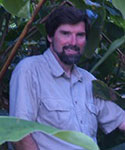
David Droney

David C DroneyProfessor Emeritus of Biology
Joined faculty in 1988
Ph.D., Syracuse University
M.S., SUNY Buffalo
B.S., SUNY Buffalo
Contact Information
Scholarly Interest
- Behavioral ecology
- Sexual selection and the evolution of social behavior
- Sexual conflict and the evolution of alternate behavioral tactics in males
- Biostatistics and experimental analysis of public health related issues
Teaching Experience
Syracuse University
Courses Taught
Behavioral Ecology
Evolution
Biology Seminar: Sex and Evolution
Publications
Droney, D.C., Musto, C.J., Mancuso, K*. Roelofs, W.L., and Linn, C.E. 2012. The response to selection for broad male response to female sex pheromone and its implications for divergence in close-range mating behavior in the European corn borer moth, Ostrinia nubilalis. Journal of Chemical Ecology, 38, 1504-1512.
Droney, D.C. and Thaker, M*. 2006. Factors influencing mating duration and male choice in the red milkweed beetle, Tetraopes tetrophthalmus (Coleoptera: Cerambycidae). Ethology, Ecology, and Evolution, 18: 173-183.
Droney, D.C. 2003. Females lay fewer eggs for males with greater courtship success in a Hawaiian Drosophila. Animal Behaviour, 65, 371-378.
Droney, D.C.2001. Male lekking duration and mating benefits in a lek-forming Hawaiian Drosophila. J. Insect Behavior, 14, 621-635.
Droney, D.C. 1998. The influence of the nutritional content of the adult male diet on testis mass, body condition, and courtship vigour in an Hawaiian Drosophila. Functional Ecology, 12, 920-928.
Droney, D.C.& Hock, M.B.* 1998. Male sexual signals and female choice in Drosophila grimshawi. J. Insect Behavior, 11,59-71.
Savin, T.J., Anderson, R.N., & Droney, D.C. 1998. Analysis of age-related changes in susceptibility to drinking water pathogens for risk assessment. ATSDR.
____1998. Case study: a cost-effectiveness analysis of DBP's and pathogens in drinking water. 2-16. For U.S.EPA-NCEA, Cincinnnati.
____1997. Case study: a decision analysis methodology for choosing among drinking water strategies. 2-16. For U.S. EPA-NCEA, Cincinnnati.
* HWS students
PROFESSIONAL AFFILIATIONS
American Society of Naturalists
Society for the Study of Evolution
International Society of Behavioral Ecology
PERSONAL STATEMENT
My primary research focus is the study of the mechanisms of natural and sexual selection so that the process of evolution can be better understood. My research has the objective of understanding ultimate causation, and thus, to better understand why the biological world "works" as it does.
My research organisms have primarily been insects because they provide a good opportunity to perform the necessary experiments to evaluate crucial evolutionary hypotheses. In particular, the Hawaiian Drosophila represents a remarkable and enormous adaptive radiation in a relatively short time period, and as such, presents researchers with a natural evolutionary "lab" to answer key questions of interest in the study of behavior and evolution. I am currently collaborating with researchers at Cornell University on a project to study the genetic and behavioral mechanisms of reproductive isolation and subsequent species formation using corn borer moths.
